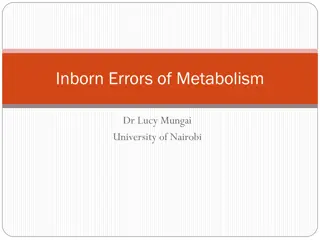Pancreas Disorders and Detection
Pancreas disorders encompass a variety of conditions affecting the pancreas, including inflammation, necrosis, and insufficiency. Laboratory detection of pancreatitis involves assessing serum amylase activity, which can vary in dogs and cats. Hyperamylasemia, increased amylase levels, is more common in dogs with pancreatitis.
Download Presentation

Please find below an Image/Link to download the presentation.
The content on the website is provided AS IS for your information and personal use only. It may not be sold, licensed, or shared on other websites without obtaining consent from the author.If you encounter any issues during the download, it is possible that the publisher has removed the file from their server.
You are allowed to download the files provided on this website for personal or commercial use, subject to the condition that they are used lawfully. All files are the property of their respective owners.
The content on the website is provided AS IS for your information and personal use only. It may not be sold, licensed, or shared on other websites without obtaining consent from the author.
E N D
Presentation Transcript
Pancreas Disorders Pancreas Disorders
Exocrine Pancreas Exocrine Pancreas Inflammation and necrosis Exocrine insufficiency
Laboratory Detection Laboratory Detection Pancreatitis is the destruction of pancreatic tissue by activated digestive enzymes. The clinical spectrum of pancreatitis includes mild subclinical disease, severe necrotizing inflammation that can be life threatening, and clinical disease that is episodic over months to years. Routine biochemical profiles lack highly sensitive and specific tests for pancreatic disease and therefore cannot be used for definitive diagnosis of pancreatitis
Enzymes or zymogens (inactive precursors of enzymes) produced and stored in acinar cells may leak into plasma during pancreatic cellular injury, resulting in increased serum activity Amylase and lipase are enzymes that are nonexclusively produced by the exocrine pancreas helpful in determining the presence of pancreatitis in dogs; But!!!! their measurement is of no utility in cats
Serum Amylase Activity Serum Amylase Activity Pancreas, liver, and small intestine are the main sources of serum amylase activity. Of these sources, the duodenal mucosa is the most likely origin of serum amylase activity in health Salivary amylase is not present in domestic animals except the pig.
In dogs, serum amylase activity may remain within the reference interval in some cases of acute pancreatitis. False-negative test results more likely to occur with serum amylase than with serum lipase. Corticosteroid administration may decrease serum amylase activity. Lipemic sera may inhibit amylase activity. This may be overcome by sample dilution or serum clearing techniques???
Hyperamylasemia is often present in dogs with pancreatitis; it is rarely observed in cats. The higher the amylase activity (equal to or greater than three- to four-fold increase), the more likely the presence of pancreatic disease. Values 7 to 10 times the reference interval have been observed with pancreatitis
Hyperamylasemia has poor specificity for pancreatitis Renal disease, Diabetes mellitus, Gastrointestinal disease, Neoplasia (e.g., Lymphosarcoma and hemangiosarcoma), Hepatobiliary disease
Because diseases other than pancreatitis may cause hyperamylasemia, both serum amylase and lipase activities should be measured in dogs to better substantiate a suspicion of pancreatitis.
Serum Serum Lipase Lipase Activity Activity Lipase activity in serum originates from multiple sources including the pancreas and stomach. The common function of lipases precludes their differentiation by assays determining serum lipase activity. Serum lipase activity in pancreatectomized dogs has been shown to be 50% of its level prior to surgery. Serum lipase activity in dogs with exocrine pancreatic insufficiency and healthy dogs has been shown to not be significantly different. Lipase is cleared from the plasma and inactivated by the kidneys. Hemolysis directly inhibits lipase activity.
Decreased clearance of plasma lipase in renal disease can result in a two- to three-fold increase in serum lipase activity. Peritonitis, Gastritis, Enteritis, bowel obstruction, visceral manipulation during laparotomy, Some hepatic disorders, Neoplasia also may increase serum lipase activity
Corticosteroid administration may increase serum lipase activity up to five times the upper end of the reference interval in the absence of histologic evidence of pancreatitis
LABORATORY TESTS LABORATORY TESTS SPECIFIC SPECIFIC FOR PANCREATIC FOR PANCREATIC DISEASE DISEASE Species-specific pancreatic lipase immunoreactivity (PLI) Trypsin-like immunoreactivity (TLI)
Species Species- -specific pancreatic lipase specific pancreatic lipase immunoreactivity immunoreactivity (PLI) (PLI) PLI has been shown to be the most sensitive and specific laboratory test currently available to veterinary practitioners for diagnosis of pancreatitis in both dogs and cats Assays have been developed and validated for both the dog and cat. Sensitivity and specificity of canine PLI for pancreatitis are reportedly 81% and 96%, respectively. Sensitivity and specificity of feline PLI for pancreatitis are reportedly 67% and 91%, respectively (when measured by radioimmunoassay). These parameters of fPLI increase with severity of disease.
A. fPLI has a sensitivity of 54% in cats with mild or low-grade/chronic pancreatitis. This level of sensitivity is higher than any other noninvasive test for pancreatitis (including serum amylase and lipase activity, feline trypsin-like immunoreactivity, radiography, abdominal ultrasound, and computed tomography). B. One study found sensitivity and specificity of fPLI to be 100% in cases of moderate to severe pancreatitis.
Glomerular filtration rate, gastritis, and oral prednisone have been shown to not affect cPLI results. In cats with experimentally induced pancreatitis, fPLI was shown to remain elevated longer than feline trypsin-like immunoreactivity (fTLI).
fPLI measurement could be of great importance for cats with other diseases. a. Pancreatitis in cats is frequently associated with other conditions hepatic lipidosis diabetes mellitus cholangitis cholangiohepatitis inflammatory bowel disease interstitial nephritis vitamin-K-responsive coagulopathy
b. Routine biochemical profiles may reveal abnormalities related to disease of other organs but do not disclose evidence of pancreatitis. Identification of pancreatitis in cats with disease elsewhere is potentially clinically relevant.
c. It is shown that a significant number of cats with diabetes mellitus have elevated fPLI values. Measurement of fPLI in diabetic cats is recommended, especially when the diabetic condition has been difficult to control.
Trypsin Trypsin- -like like immunoreactivity immunoreactivity (TLI) (TLI) TLI is a species-specific assay that detects trypsinogen and trypsin in serum. Trypsinogen and trypsin have been shown to originate almost exclusively from the exocrine pancreas in dogs. Though studies have not been performed, the origin of these proteins in cats is believed to be only the pancreas. TLI, therefore, is highly specific for pancreatic disease. TLI measurement is an indirect test of pancreatic function. In health, only a small amount of trypsinogen and very little trypsin are secreted into the vascular space. Pancreatic injury/inflammation results in increased serum levels of trypsinogen and trypsin. Sensitivity and specificity of canine TLI are approximately 35% and 65%, respectively. Overall sensitivity and specificity of feline TLI for pancreatitis are approximately 30% and 75%, respectively.
TLI may be increased with renal insufficiency. Increased TLI also has been reported in malnourished dogs without histologic evidence of pancreatitis.
In summary, serum TLI can be useful in the diagnosis of pancreatitis if renal disease is not present. The magnitude of increased TLI does not always correlate with the severity of pancreatitis.
Serum biochemical abnormalities Serum biochemical abnormalities Fasting hyperlipidemia a. Hypertriglyceridemia (hyperlipemia) Lipoprotein lipase, a plasma lipemia-clearing enzyme produced by the pancreas, may be inactivated in pancreatic necrosis, resulting in a transient lipemia. Diabetes mellitus as a sequela to pancreatitis may cause hyperlipemia. b. Hypercholesterolemia
Hyperproteinemia (usually relative) or hypoproteinemia (including hypoalbuminemia) may be observed. Prerenal and renal azotemia may result from a decreased glomerular filtration rate due to dehydration. Increased ALT and AST activities may occur from hepatic ischemia or the toxic effects of products absorbed by portal blood. Increased ALP activity and hyperbilirubinemia may result from cholestasis secondary to hepatocellular fatty change or inflammation causing compression of bile canaliculi or the common bile duct.























